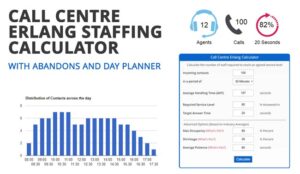Staffing Variance Equation – Daily
Hi, looking for some input.
We are having a debate on our PMT team. I am a forecast analyst for a call center, and am responsible for capacity planning also. A recomendation from one of our PMT members was to calculate daily staffing variance as a measurement of call center performance. His equation is simple (Sum of total daily actual staff logged in (in hours) / Sum of total daily forecast staff requirement (in hours)) = staffing variance. My problem with this is obvious – we forecast staff at the 1/2 hour interval. We could literally schedule no staff for the first 6 hours of day, and double our requirement of last 6 hours and show a positive staffing variance – show to have staffed above forecast using this equation.
I look at daily staffing intervals, and metrics such as shrink when I do variance explanation. However, the team wants to use a daily formula, and I am the only one pushing back. Does anyone have an accurate fair calculation for producing Staffing Variance at the daily level? Or can point me in the right direction?
Any help would be great. Thanks.
Question asked by B
Staffing Variance Equation – Possible Solution
The base my daily variance on the sum of the absolute difference between the forecast and actual of each 1/2 interval. For example:
FOR ACT ABs
100 95 5
75 95 20
70 65 5
=============
245 255 30
Then 30/245 = 12.24%, which is your total daily variance across all intervals. This will give you a more accurate variance without having to retain each interval.
With thanks to Anthony
Forecast-to-Actual Percentage
Forecast-to-Actual Percentage is the basic formula for judging forecast accuracy. The result of the formula is the percentage the forecast is over or under the actual value. The formula for Forecast-to-Actual Percentage is:
(forecast – actual)/actual.
This is the most commonly used formula in determining forecast accuracy. It is easy to explain and understand. However, this formula also has a significant flaw-the average performance for a time period does not reflect the variability of the forecast during that period. This is true because the daily over and under forecasts cancel each other out.
I hope this information is helpful to you.
With thanks to Mohamed
Mohammed
It’s not just about forecast accuracy, staffing levels will also account for non call related activities.
I suggest that whilst a daily variance is Ok for a high level view that you also report the range of the variances by interval, a 0% variance over a day will mask many variances.
Plot the number of ‘overs’ and ‘unders separately’ expressed as a %, for e.g.
Of the xx half hour periods in an operational day:
75% were over staffed
25% were understaffed
Nett effect was x% over/under staffed (This may well report 0% variance) Good?
Maybe, but if you also report the following it will give a true picture.
Of those periods that were overstaffed the range was from x to y
Of those periods that were understaffed the range was x to y.
With thanks to Steve
Author: Jonty Pearce
Published On: 12th Apr 2022 - Last modified: 3rd Oct 2025
Read more about - Call Centre Questions, Call Centre Answers





































